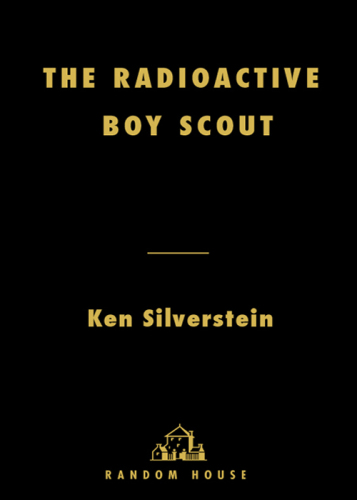
The Radioactive Boy Scout
The True Story of a Boy and His Backyard Nuclear Reactor
فرمت کتاب
ebook
تاریخ انتشار
2004
Lexile Score
1300
Reading Level
9-12
ATOS
10.1
Interest Level
9-12(UG)
نویسنده
Ken Silversteinشابک
9781588363565
کتاب های مرتبط
- اطلاعات
- نقد و بررسی
- دیدگاه کاربران
نقد و بررسی

January 12, 2004
In the summer of 1995, a teenager in a Detroit suburb, a mediocre student with a relentless scientific curiosity, managed to build a rudimentary nuclear breeder reactor in a shed behind his mother's house, using radioactive elements obtained from items as ordinary as smoke detectors. He got so far along in his efforts that when the Feds finally caught up with him, the EPA used Superfund money (usually spent on the worst hazardous waste sites) to clean up the shed. Building on a Harper's
article, Silverstein, an investigative reporter for the L.A. Times
, fleshes out David Hahn's atomic escapades, and though it takes a while for the story to kick into gear, readers will be sucked in not just by how Hahn did it but how he was able to get away with it. His "pathologically oblivious" father comes in for the sharpest criticism, but Silverstein takes note of the teachers who failed to pick up on Hahn's cues (his friends called him "glow boy") and the Department of Energy official who offered crucial tips on creating a neutron gun. Silverstein also examines the pronuclear ideology Hahn picked up in the Boy Scouts (where he had earned an atomic energy merit badge) and dated government publications that touted nuclear power while glossing over setbacks in the troubled breeder reactor program. And though there's little mention of how easily terrorists could duplicate Hahn's feat, perhaps the accomplishment of one obsessed teen is scary enough in its own right. Agent, Melanie Jackson.

February 1, 2004
Judging from this book, Los Angeles Times investigative reporter Silverstein is good at his job. Unfortunately, the kind of well-researched human-interest story that makes for good reading in a newspaper article is less than gripping in a 200-page book. His detached third-person reporting gets the story across but never draws the reader into the life of David Hahn-the troubled youth who tried to build a breeder nuclear reactor in a garden shed-or any other party involved. Rather, it merely engenders horror at the utter disregard that David had for himself and everyone around him and dismay at the complete lack of guidance or supervision from adults in his life. There are minor inaccuracies scattered throughout-Silverstein defines half-life as the amount of time required for the intensity of radiation to decay by half rather than as the time for half of the radioactive particles to have decayed-so it should not necessarily be classified as a science book. However, it is an important story that many patrons in public libraries will find interesting, if disturbing.-Marcia R. Franklin, Academy Coll. Lib., Bloomington, MN
Copyright 2004 Library Journal, LLC Used with permission.

October 1, 2004
Adult/High School -After his grandfather gave him a used copy of The Golden Book of Chemistry, David Hahn became obsessed with science and conducting his own experiments. As an Eagle Scout, he began work on the Atomic Energy badge by making a model of a nuclear reactor. Not satisfied with that, he set out to build a real one. He read voraciously and scavenged for materials, finding some of the items he needed in gas-lantern mantels and smoke detectors. By posing as a professor, he used the Nuclear Regulatory Agency to get much of the information that he needed. And in the summer after his junior year in high school, he nearly succeeded in building a reactor in the potting shed behind his house. He created a site so hazardous that it became an EPA's Superfund site. Silverstein writes in a light, easy-to-read style even as he explains the atomic theory behind Hahn's experiments. He sees the young man's dysfunctional family and his teachers' lack of time or interest in finding out more about "Glow Boy's" pursuits as the framework for Hahn's misguided conduct. Readers will have plenty to think about and discuss after reading this amazing tale of an adolescent loner's single-minded pursuit of a dangerous goal.-Jane S. Drabkin, Chinn Park Regional Library, Woodbridge, VA
Copyright 2004 School Library Journal, LLC Used with permission.

December 1, 2003
Lighting fireworks, participating in scouting, hanging with a girlfriend: these normal boyhood activities belied the strangeness of Detroit-area teenager David Hahn. Silverstein recounts how Hahn, while a high-school student in the early 1990s, tried to assemble a breeder nuclear reactor in a garden shed. Seeking the origins of such audacity, the author extensively interviewed Hahn and worked backward from the day in 1995 when EPA personnel clad in ventilated moon suits took away Hahn's radioactive material. To Silverstein, Hahn was two things at once: a kid out of time who imbibed 1960-style nuclear optimism from a chemistry book published that year and a kid of the times, the product of divorce. Neither parents nor stepparents, consumed by work and personal problems, supervised young David, who, utterly heedless of danger, re-created the experiments of Marie and Pierre Curie with a monomania that fed his fantasy of going nuclear. Aghast at Hahn's recklessness but amazed by his mad-scientist resourcefulness, Silverstein regales readers with an irresistible tale.(Reprinted with permission of Booklist, copyright 2003, American Library Association.)

























دیدگاه کاربران